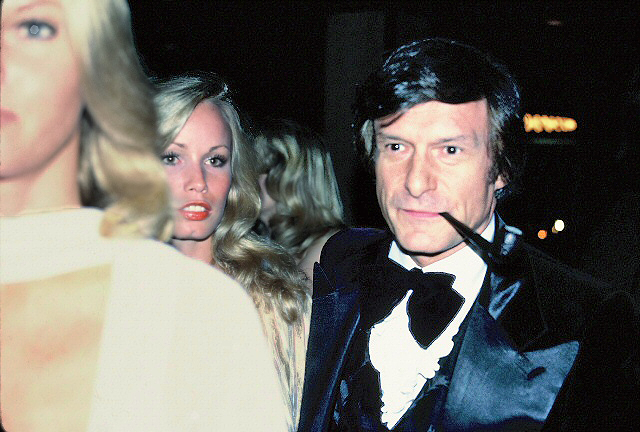Should Hugh Hefner be Buried Next to Marilyn Monroe?
Hugh Hefner, the founder of Playboy magazine, died on September 27 at the age of 91. A leader in the sexual revolution of the second half of the twentieth century, Hefner has been a controversial figure throughout his life. Playboy magazine launched in 1953 and hurled his empire into mainstream success that spanned media, later including multiple television shows, clubs, restaurants, and the notoriously excessive Playboy Mansion.
Throughout his career, Hefner considered himself a feminist. He was committed to sexual liberation, a break with the prudish and repressed mores our society had espoused, and he was convinced that his progressive openness about sex was empowering. As ABC news reports, “asked by The New York Times in 1992 of what he was proudest, Hefner responded: “That I changed attitudes toward sex. That nice people can live together now. That I decontaminated the notion of premarital sex. That gives me great satisfaction.””
Hefner certainly did a lot to make sex more mainstream and to diversify our conception of normal sexual lifestyles beyond marriage and monogamy. The confining expectations of post-war American society included monogamy and marriage. These expectations kicked in very early in life, and Hefner tapped into the anxieties and frustration of a generation of men with his magazine and his apparent intended message, which pushed the boundaries of normal relationships. He was an advocate for abortion rights and marriage equality and his Playboy clubs were fully integrated in the 1960s despite the Jim Crow South.
Embedded in these progressive stances, the liberation that Hefner’s enterprise envisioned and played a role in establishing was very much filtered through his perspective as a rich white man. Playboy magazine was directed explicitly towards men: the first issue included the warning, “We want to make clear from the start, we aren’t a ‘family magazine. If you’re somebody’s sister, wife or mother-in-law and picked us up by mistake, please pass us along to the man in your life and get back to your Ladies’ Home Companion.””
Hefner’s anti-matrimony and anti-monogamy lifestyle was progressive – it marked a progression past the constraining mores of the previous system – but it focused on the lives men could be living in such a new system. The women imagined in Hefner’s liberated system fit the mold of the anti-wife, there to facilitate this new freedom from previous male drudgery. His clubs were solely for men, his magazines targeted a very traditional notion of masculinity, comforting the “hen-pecked,” and he consistently was in a position where he had to defend his harem-like existence. Barbara Ehrenreich, in her book The Hearts of Men: The American Dream and the Flight from Commitment, characterizes the lifestyle Playboy promoted as “coherent program for the male rebellion: a critique of marriage, a strategy for liberation (reclaiming the indoors as a realm for masculine pleasure) and a utopian vision (defined by its unique commodity ensemble).” With men “reclaiming” the indoors, and Hefner establishing clubs and magazines for liberated men, the liberation of women is limited to the sheets of the magazine and the waitresses of the clubs.
As Jeet Heer puts it in an editorial for the New Republic, “What derailed the male revolt was the female revolt. Women reasonably asked themselves: If men like Hefner were abandoning the traditional claims of chivalry, then what were they offering? The answer: a patriarchy without any promise of protection—a raw deal.”
When women began asking what such a utopia had to offer them, embodied in the form of Gloria Steinem posing as a “bunny” and reporting on the experience, the women surrounding Hefner’s liberation were shown to be experiencing poor working conditions. In response, Susan Braudy was commissioned in 1969 by Playboy to write an expose of the feminist movement to undermine Steinem’s position. Braudy’s piece failed to be the negative expose Playboy was hoping for, and Hefner wrote an angry memo in response, saying, “The women’s movement is rejecting the overall roles that men and women play in our society—the notion that there should be any differences between the sexes whatever other than the physiological ones. It is an extremely anti-sexual unnatural thing they are reaching for. It is now up to us to do a really expert, personal demolition job…. These chicks are our natural enemy.”
The women’s liberation that Hefner always assumed came along with man’s liberation didn’t show full-throated support for his efforts to liberate them. To reject the roles that Playboy’s masculinity lay out for women make “these chicks” Hefner’s “natural enemy.”
Over the decades, there have been many women who have chosen to live the “Playboy Lifestyle”, by posing for the magazine, living in the Mansion, dating Hefner or one of his friends, etc. Women over the decades have shared stories of abuse and degradation, going on to sue Playboy, Hefner, or his associates for sexual assault and rape, recently including allegations towards Bill Cosby.
Even in his death, Hefner raises controversy. In 1992, he purchased the burial plot next to Marilyn Monroe’s for $75,000. He didn’t have any personal relationship with Monroe, never having met her and only speaking on the phone with her once, but she was the first cover girl for Playboy magazine. He purchased nude photos of Monroe without her consent, without paying her anything, and thanks to this purchase, ensured a grand launch for his magazine.
According to an interview she gave titled, “Marilyn: Her Life in Her Own Words,” Marilyn was embarrassed by the shoot, which she did early in her career in order to make ends meet, and didn’t sign her “official” screen name to in order to further distance herself from it. She received the original modeling fee and had to purchase a Playboy just like everyone else to see what the magazine had done with the photos of her.
Monroe’s career benefited from the attention garnered from the spread. However, she was not paid for the use of her image, nor she did not consent to its use in this manner – though she did give up rights to the images. The exploitative structure of modeling and acting is fraught. Setting these ethical issues aside, what can we say about Hefner’s behavior that arguably marks his last act on earth: being buried next to Monroe?
In interviews about his purchase, Hefner explained his reasoning: “I’m a believer in things symbolic. Spending eternity next to Marilyn is too sweet to pass up.” The symbolism may go deeper than Hefner intended. The context of Hefner’s moral commitments and legacy from his empire informs this action.
Fans have tweeted support, calling Hefner a “legend” for his purchase, seeing it as a continuation of his bachelor lifestyle, or appreciating the way that this makes the Playboy legacy come full circle with Hefner buried next to the first Playboy Sweetheart. Critics also see the behavior as a continuation of Hefner’s actions in life, constructing a reality that suits him without regard to the preferences of the women in his sphere.
Obviously, Monroe doesn’t get a say in the matter. Her burial place is being treated as a symbol that Hefner can manipulate to his preferences rather than something that can have meaning in its own right. This critique is the same form that Hefner faced throughout his playboy existence. However, there is an ethical twist here: Monroe is dead. To what extent can someone who is no longer alive be harmed?
First, we should note that there is an element to the behavior that is common and troubling to this behavior. Hefner is pursuing Monroe regardless of her wishes and to all appearances against her wishes. This sort of behavior – placing yourself in someone’s life, insisting on a place of significance despite an awareness of their preference for otherwise – has been glorified in movies and television shows as romantic. Consider: “Romantic Comedies: When Stalking has a Happy Ending” and “11 Movie Scenes that Teach us Stalking is Romantic.” The choice of Hefner’s grave site is meant to “honor” Monroe in a similar way that the persistence and devotion in these romantic comedy tropes is meant to signal care (see: Kendra Wilkinson saying Monroe should be “honored” by Hefner’s choice). However, in each of these cases, something crucial is missing: the perspective of the object of the subject’s affection, or action. The agency of the other is absent in the character’s deliberation.
Consider a real world example. On September 12, Luke Howard played a piano in Bristol until his girlfriend would take him back. He produced a spectacle of just how committed he was to gaining her good graces and re-entering a relationship with her. But the spectacle failed to engage the perspective of the woman at all, and instead focused on Howard’s wishes completely. (He had to stop when someone punched him in the head).
So, what can we say about Hefner’s behavior in choosing his grave site? He was neglectful of Monroe’s wishes, which likely would be averse to his actions. With people praising and criticizing his behavior, articulating the manner in which his behavior could be immoral is an interesting question.
Is Marilyn Monroe worse off with Hefner buried next to her? Many are revolted by these circumstances because they are apparently against what she would want, and when things happen against someone’s wishes that is a prime case of harm.
According to Aristotle, to judge whether someone has lived well is a difficult task. In order to come to a conclusion on the matter, we would have to wait until well after they have died, for their good life would depend not just on their behavior in life, but also their reputation after death and the well-being of their friends and family. For instance, perhaps we wouldn’t say that someone had a good life if what she set aside for their widower got lost in the stock market a week after she died and her widower lived destitute.
It would be consistent with this view that Hefner’s actions are affecting the quality of Monroe’s life directly. He is making things “go worse” for her, and it is appropriate therefore to be indignant on Monroe’s behalf.
However, this isn’t the only reasonable position. Marilyn Monroe no longer exists, here in the world. Thus, it is not straightforward how she, or her well-being, can be harmed. Those that care about her and her well-being can be harmed and saddened on her behalf, of course. Hefner’s grave site choice is thus upsetting those individuals who have a legitimate interest in Monroe’s memory being respected in a particular way. Along these lines, Monroe herself is not being harmed, but rather her close advocates would be harmed by Hefner’s behavior.
Finally, beyond the harm to individuals that may be unreasonable given the fact that Monroe doesn’t exist to experience the harm of the behavior, we could consider the symbolism or social meaning of the behavior, given how public it is. Hefner declares he was aiming for a symbolic action in selecting this grave site, and his life and legacy has existed in the context of sexual politics. Taking Monroe’s grave as a symbol for his own memoriam speaks to his picture gender relations, and our response and interpretation of it speaks to our own.





